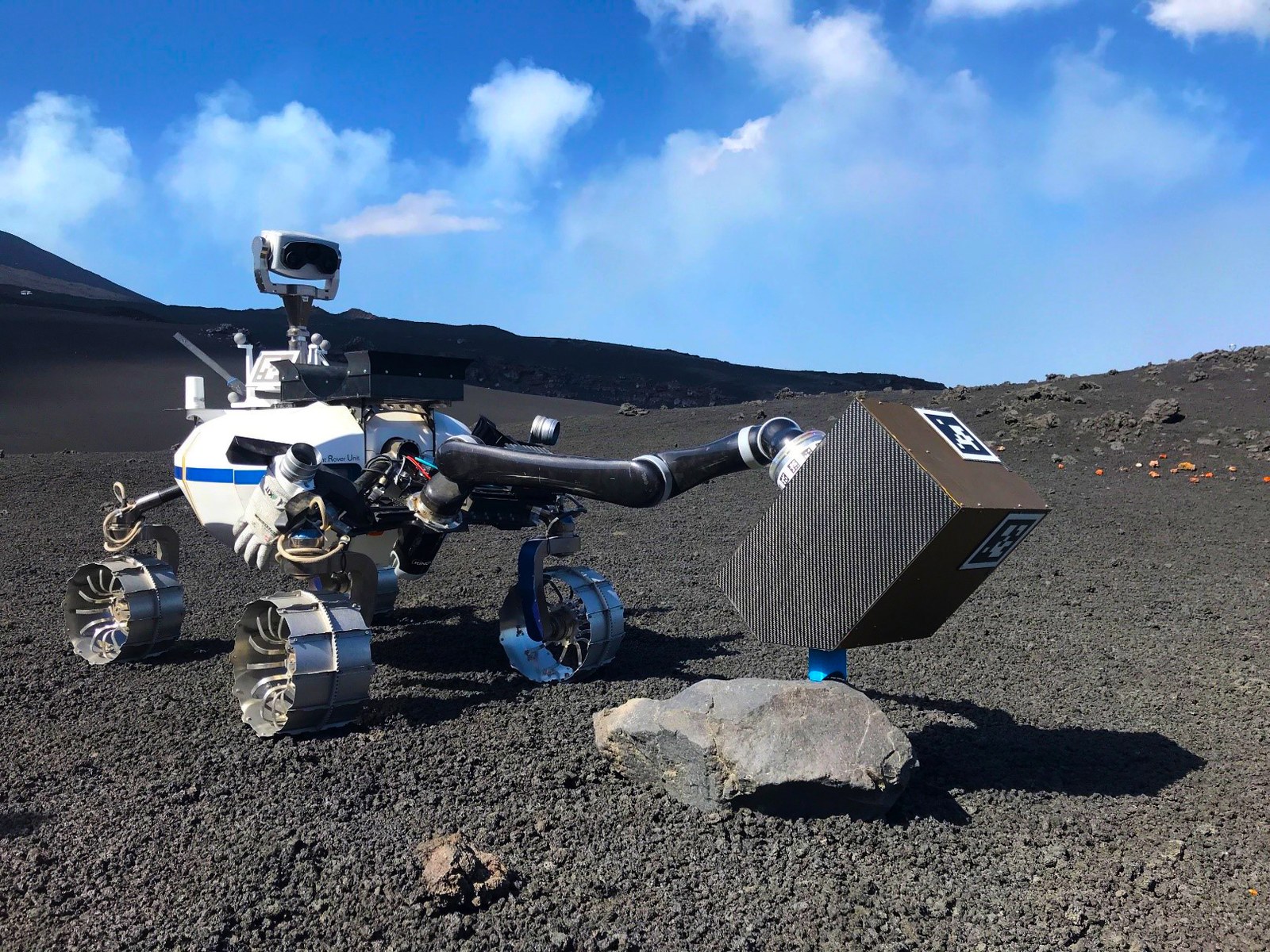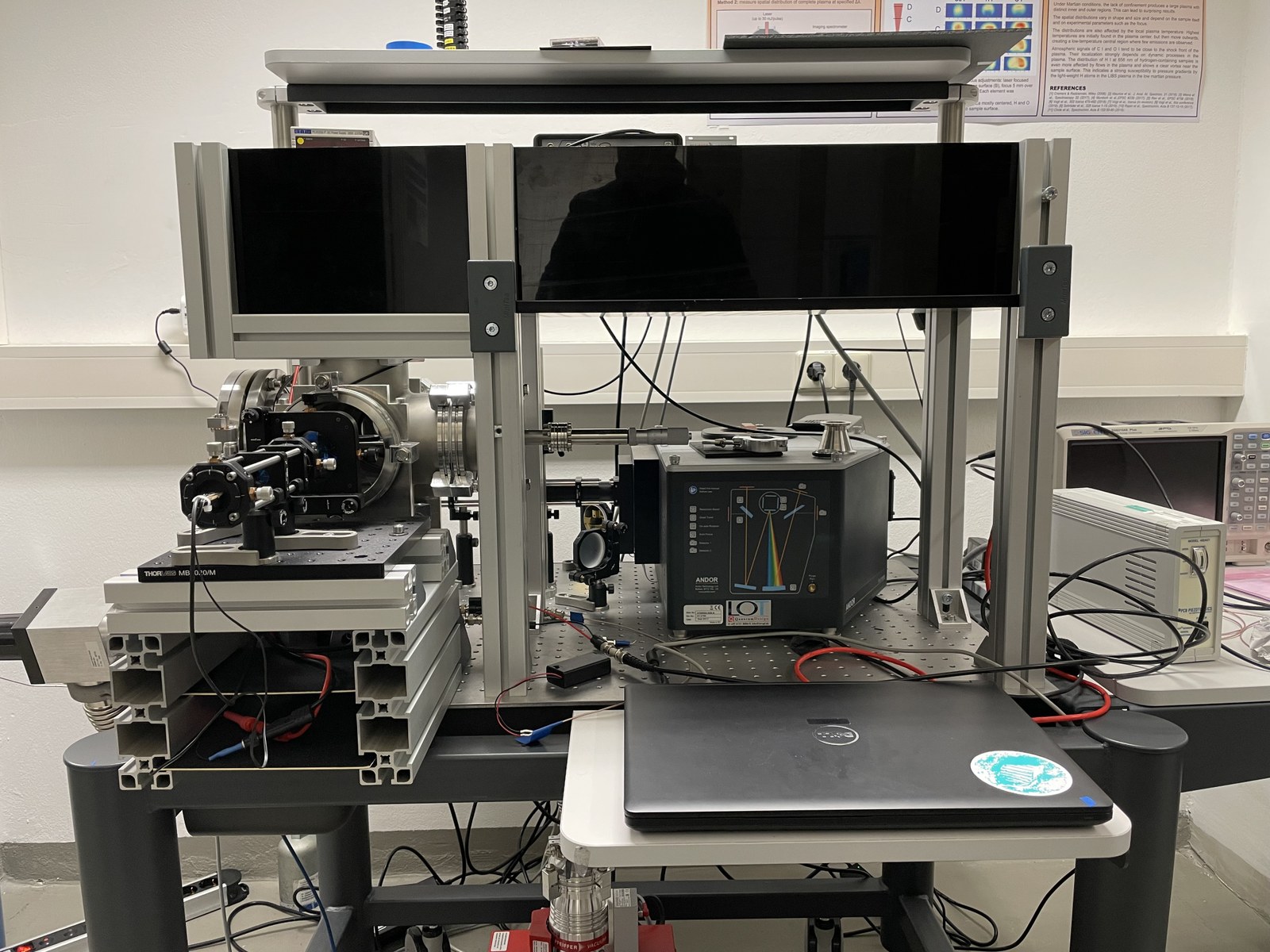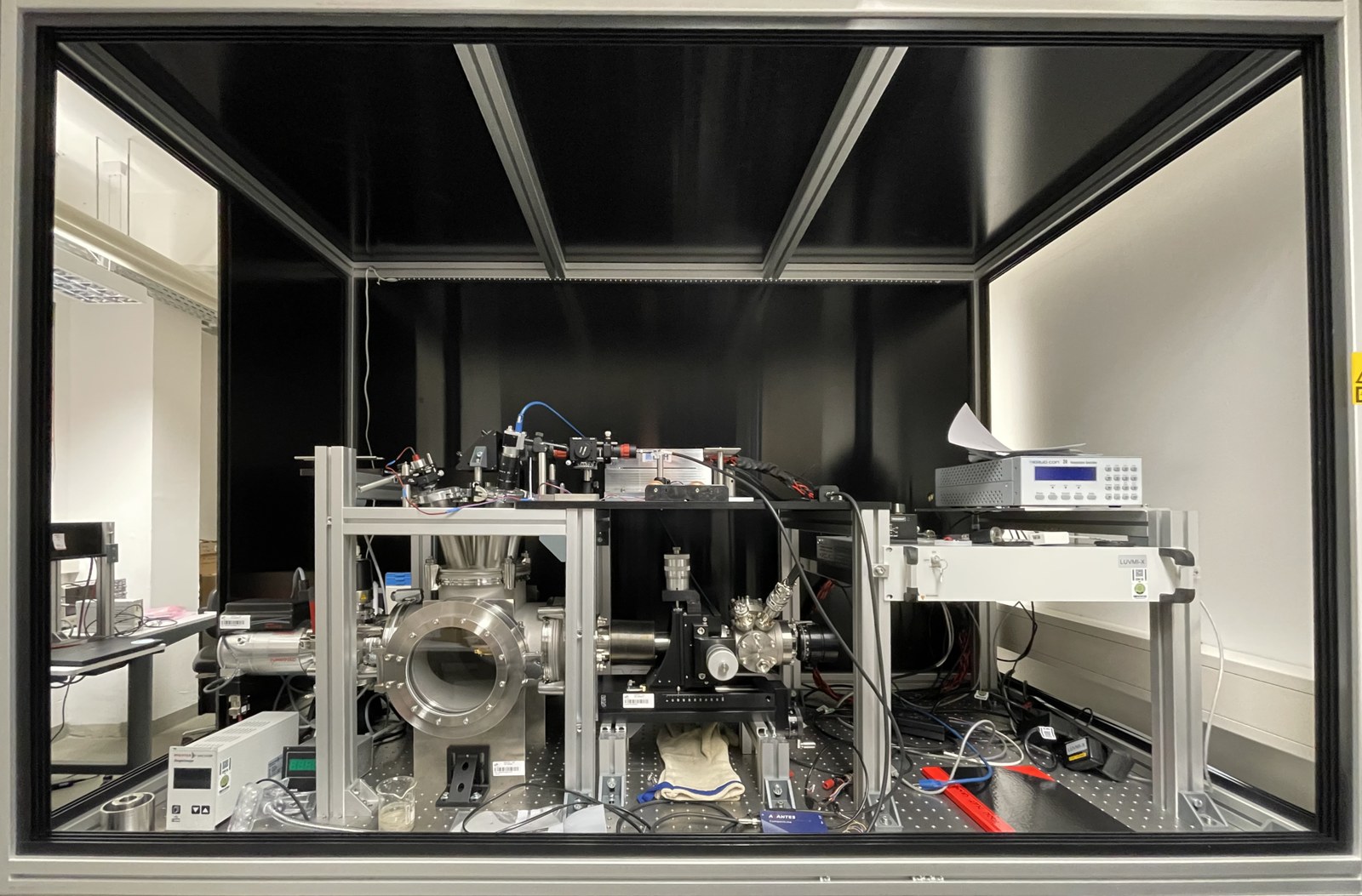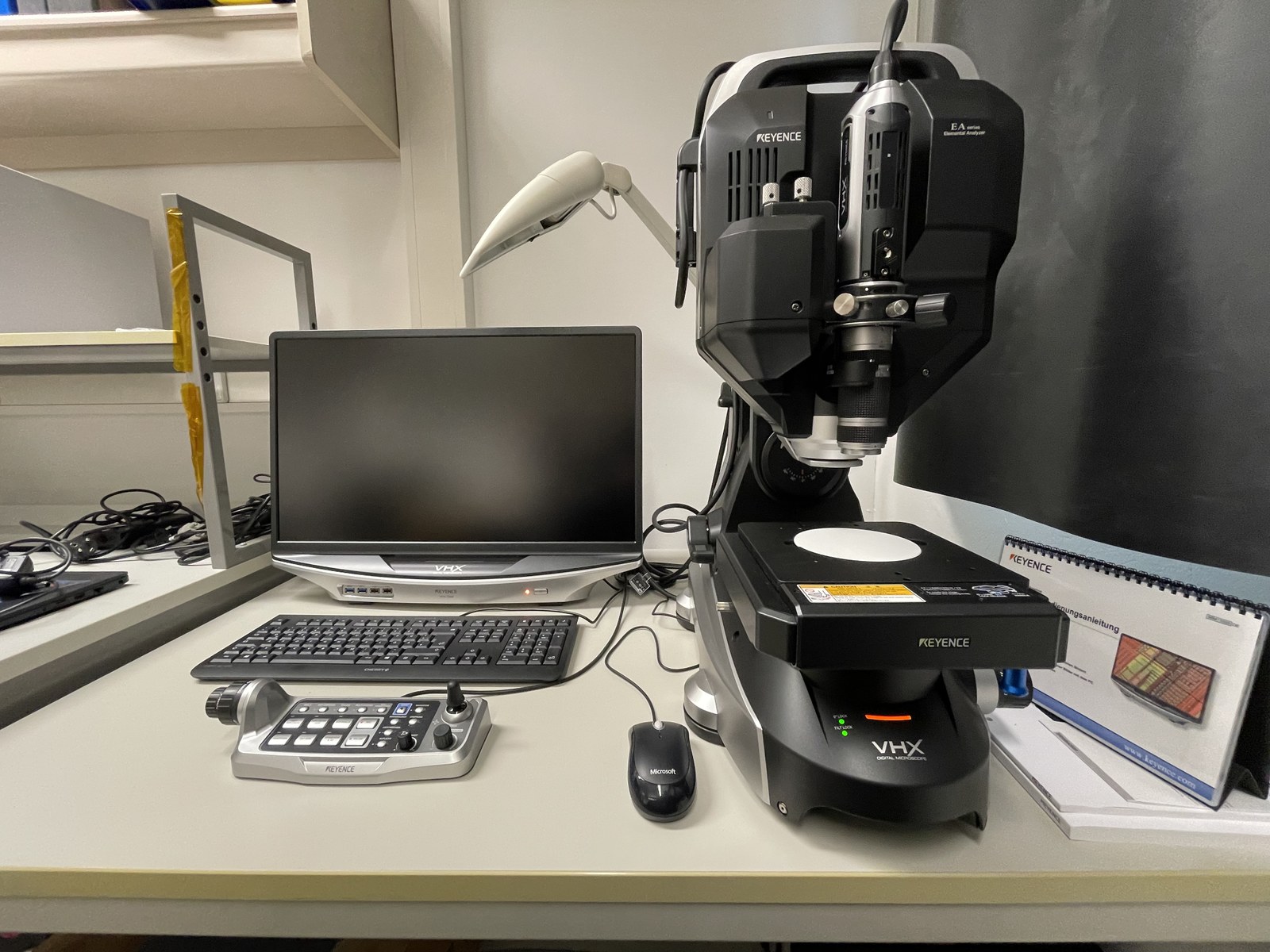Labs & Techniques
Laser-induced breakdown spectroscopy

LIBS is a spectroscopic technique that is of great interest for use as a payload in robotic planetary exploration missions. It uses a pulsed laser to ablate sample material, which evolves into a plasma. The plasma emissions are recorded with a spectrometer. The spectra show intense atomic, ionic, and molecular features that correspond to the elements in the sample and the ambient atmosphere. LIBS is sensitive to nearly all elements, making it a powerful tool for investigating the chemical composition of rocks and soils on other planetary bodies. Since laser and spectrometer require only optical access to a target, measurements can be made over distances of several meters. The first LIBS instrument to be used in space exploration is the ChemCam instrument onboard NASA’s Curiosity rover on Mars. Its successor SuperCam on NASA’s latest Mars rover Perseverance combines LIBS with Raman and infrared spectroscopy and also includes a microphone. Our team is involved in both missions for operations of the ChemCam and SuperCam instruments and analyzing the data obtained on Mars.
Raman Spectroscopy
Raman spectroscopy is a common laboratory technique that is used to analyze the structure and bonds of a sample. Minerals and organic compounds have characteristic Raman spectra, making the technique valuable for identifying samples directly. The technique is therefore very promising for in-situ planetary exploration and can be used both to analyze rocks and soils and even to find potential traces of life. On NASA’s Perseverance rover there are two payloads with Raman capability, SHERLOC and SuperCam, which are the first extraterrestrially employed Raman instruments. The RAX instrument developed at DLR-OS for JAXA’s MMX mission to Phobos will be the third Raman instrument for extraterrestrial applications.
Reference:
T. Hagelschuer, U. Böttger, M. Buder , Y. Bunduki, Y. Cho, E. Dietz, T., H.-W. Hübers, S. Kameda, E. Kopp, A. Moral Inza, M. Pertenais , G. Peter , A. Pohl, O. Prieto-Ballesteros, K. Rammelkamp, S. Rockstein, S. Routley, S. Rufini, F. Rull, C. Ryan, T. Säuberlich, F. Schrandt, S. Schröder, S. Ulamec, K. Westerdorff, “RAX: The Raman spectrometer for the MMX Phobos rover.”, Proceedings of IAC 2022, IAC-22-A4.4.8 (2022).
S. Schröder, U. Böttger, M. Buder , Y. Bunduki, Y. Cho, E. Dietz, T. Hagelschuer, H.-W. Hübers, S. Kameda, E. Kopp, A. Moral Inza, M. Pertenais , G. Peter , A. Pohl, O. Prieto-Ballesteros, K. Rammelkamp, S. Rockstein, S. Routley, S. Rufini, F. Rull, C. Ryan, T. Säuberlich, F. Schrandt, S. Ulamec, T. Usui, K. Westerdorff, “RAX: The Raman Spectrometer on the MMX Rover for in-situ Surface Analysis on Phobos”, 54th LPSC, #2549 (2023).
Combination of LIBS and Raman spectroscopy
In our group, we investigate the potential of a combined LIBS/Raman instrument with a miniaturized laboratory setup using a pulsed LIBS laser and a continuous-wave Raman laser. Effects of LIBS on subsequent Raman spectroscopy are investigated as well as approaches to best analyse the combined data.
References:
S. Schröder, K. Rammelkamp, F. Hanke, I. Weber, D.S. Vogt, S. Frohmann, S. Kubitza, U. Böttger, H.-W. Hübers, “Effects of pulsed laser and plasma interaction on Fe, Ni, Ti and their oxides for LIBS Raman analysis in extraterrestrial environments.“, Journ. of Raman Spectroscopy 51, 1667 (2019).
K. Rammelkamp, S. Schröder, S. Kubitza, D.S. Vogt, S. Frohmann, P.B. Hansen, U. Böttger, F. Hanke, H.-W. Hübers, “Low-level LIBS and Raman data fusion in the context of in situ Mars exploration.“, Journ. of Raman Spectroscopy 51, 1628 (2019).
LIBS for Mars, Moon, and other solar system bodies
Our LIBS setups use simulation chambers that can be depressurized and filled with different gas mixtures in order to simulate the atmospheric pressure and composition found on other planetary bodies. We use a Mars-analog gas mixture of >95% CO2 at pressures of 6-8 mbar to simulate the martian atmosphere. Our setups are capable of reaching pressures as low as 10-5 mbar. Next to feasibility studies with a focus on currently relevant questions in the context of present and upcoming planetary missions such as for the Moon and Mars, we are developing and testing prototype components.
References:
K. Rammelkamp, S. Schröder, B.A. Lomax, E. Clavé, Heinz-Wilhelm Hübers, "LIBS for prospecting and Raman spectroscopy for monitoring: two feasibility studies for supporting in-situ resource utilization", Front. Space Technol. 5:1336548. doi: 10.3389/frspt.2024.1336548 , (2024).
S. Schröder, K. Rammelkamp, D.S. Vogt, O. Gasnault, H.-W. Hübers, “Contribution of a martian atmosphere to laser-induced breakdown spectroscopy (LIBS) data and testing its emission characteristics for normalization applications.”, Icarus 325, 1 (2019).
D.S. Vogt, S. Schröder, K. Rammelkamp, P.B Hansen, S. Kubitza, H.-W. Hübers, “CaCl and CaF emission in LIBS under simulated Martian conditions.“, Icarus 35, 113393 (2020).
D.S. Vogt, S. Schröder, L. Richter, M. Deiml, P. Weßels, J. Neumann, H.-W. Hübers, “VOILA on the LUVMI-X Rover: Laser-Induced Breakdown Spectroscopy for the Detection of Volatiles at the Lunar South Pole”, Sensors 22, 9518 (2022).
Vacuum-UV LIBS
In addition of investigating LIBS at the commonly used spectral range between 230 nm and 900 nm, we also investigate the potential of the vacuum-UV spectral range between 100 nm and 200 nm, where many interesting elements (e.g. C, H, N, O, P, S, Cl) have their strongest emission lines. This spectral range is usually absorbed in the atmosphere and is therefore most interesting for LIBS applications in vacuum conditions, where atmospheric absorption does not occur.
Reference:
S. Kubitza, S. Schröder, E. Dietz, S. Frohmann, P. B. Hansen, K. Rammelkamp, D. S. Vogt, H.-W. Hübers, “Detecting sulfur on the Moon: The potential of vacuum ultraviolet laser-induced breakdown spectroscopy.”, Spectrochim Acta B 174, 105990 (2020).
LIBS for field tests
With a handheld LIBS instrument, we are able to do in-situ field experiments at sites that are geologically analogue to martian and lunar environments. The data from these experiments can be analyzed by multivariate data analysis in order to obtain statistical models that can classify geological targets or improve the quantification of their chemical composition.
In the framework of the Helmholtz ARCHES project, a LIBS instrument was built into a modular payload box that can be handled by DLR’s Lightweight Rover Unit (LRU) from the DLR Institute of Robotics and Mechatronic. During the ARCHES demonstration mission in June 2022 at a lunar analogue site at Mt. Etna, Sicily, all tests ran successfully: the LRU acquired LIBS data in the field which were transferred to the operations center via the mission network and visualized and analyzed with dedicated software developed by the team.
Next to being used for the exploration of extraterrestrial surfaces, an autonomous mobile robot equipped with a LIBS instrument can also be useful for terrestrial purposes such as scouting for particular materials in terrains that are difficult to reach or even inaccessible for humans.

References:
S. Schröder, F. Seel, E. Dietz, S. Frohmann, P.B. Hansen, P. Lehner, A.F. Prince, R. Sakagami, B. Vodermayer, A. Wedler, A. Börner, H.-W. Hübers, "A Laser-Induced Breakdown Spectroscopy (LIBS) Instrument for In-Situ Exploration with the DLR Lightweight Rover Unit (LRU)", Appl. Sci., 14(6), 2467; https://doi.org/10.3390/app14062467, (2024).
K. Rammelkamp, S. Schröder, G. Ortenzi, A. Pisello, K. Stephan, M. Baqué, H.-W. Hübers, O. Forni, F. Sohl, L. Thomsen, V. Unnithan, “Field investigation of volcanic deposits on Vulcano, Italy using a handheld laser-induced breakdown spectroscopy instrument.“, Spectrochim. Acta B 177, 106067 (2021).
LIBS Plasma Dynamics and LIBS Acoustic Signal
To support the analysis of spectral and acoustic LIBS data from Mars, we investigate the dynamics of the LIBS plasma and the generation of the acoustic LIBS signal in laboratory studies. For this, we use a setup combining the capabilities of plasma imaging, schlieren imaging and acoustic recordings.
The plasma imaging system allows as to visualize the spatial distribution and temporal evolution of the LIBS plasma and specific species within it. These measurements can improve the models that are used to analyze LIBS spectra and can take the effects of different atmospheric environments, such as those on Mars, into account. The schlieren imaging system can show density variations like those induced by the LIBS shock wave and the microphone can be used to record the acoustic LIBS signal. By combining all three methods, we can investigate the generation of the acoustic signal over four orders of magnitude in time and analyze the influence that experimental parameters and sample properties have on the generation of the acoustic LIBS signal. Lab studies regarding the acoustic LIBS signal at Martian atmospheric conditions are of particular importance, since NASA’s latest Mars Rover Perseverance carries a sensor suite called SuperCam that combines LIBS spectral capabilities with acoustic LIBS recordings for the first time in the history of space exploration.

References:
Vogt, D. S., Schröder, S., Frohmann, S., Hansen, P. B., Seel, F., Gensch, M., & Hübers, H. W. (2022). Spatiotemporal characterization of the laser-induced plasma plume in simulated Martian conditions. Spectrochimica Acta Part B: Atomic Spectroscopy, 187, 106326.
Seel, F., Schröder, S., Vogt, D. S., Dietz, E., Hübers, H. W., & Gensch, M. (2023). Generation and evolution of laser-induced shock waves under Martian atmospheric conditions. Icarus, 394, 115405.
Maurice, S., Chide, B., Murdoch, N., Lorenz, R. D., Mimoun, D., Wiens, R. C., ... & Williford, K. (2022). In situ recording of Mars soundscape. Nature, 605(7911), 653-658.
Setups

DLR

DLR

DLR
